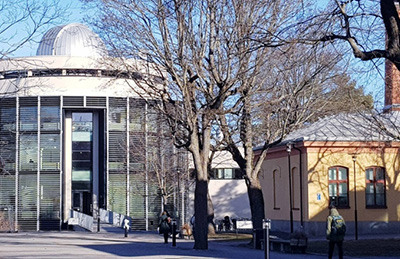News on the SOLARNET Mobility Program
The successful applicants of SOLARNET’s 1st Mobility Programme call are beginning to set off on adventures to foreign lands, hoping for exciting discoveries and making new acquaintances.
The mobility of researchers is the key to sharing knowledge and skills around the world, fostering a culture of cooperation amongst the scientific community. To aid this, SOLARNET offers a Mobility Programme that is focused on helping young and experienced researchers within the Solar Physics community to connect with individuals and institutes who are able to further their research and development. The first call for proposals was released early this year, in April 2019 and six science cases were selected to be funded. The supported proposals mainly belonged to early career researchers that included PhD students and post-doctoral research associates. One senior member of the community was also given assistance. While the Mobility Programme provides an opportunity for extended periods of collaboration, SOLARNET also offers financial support for attending and hosting scientific meetings. Markus Roth, the Lead Project Scientist of SOLARNET, said “Mobility is a key tenet underlying SOLARNET. We are aiming to draw the EU Solar Physics community closer together, as well as bringing in expertise from our international colleagues.”
This time round, the researchers supported came from Russia, Italy, Germany, along with 3 from the UK. And, if not already, they will soon be setting off to visit their host institute, with destinations across the EU and US. The stay at the host institute lasts for a period of six to twelve weeks, providing the opportunity for an intense learning and collaborative experience working with world leading experts in their fields. The researchers will also undoubtedly become involved in the life of the department, as well as the local community. The list of research topics involved in the visits is as numerous as the destinations, with scientific topics covering Coronal Mass Ejections, helio-seismology, space weather prediction, numerical radiative transfer.
Philip Lindner is currently a first year PhD student at the Leibniz-Institute for Solar Physics (Germany) and is heading to Stockholm University (Sweden) to work with Dr. Jaime de la Cruz Rodriguez. “I believe that this visit will enable me to establish professional contacts and provide a delightful learning experience altogether.” said Philip, before he began. During his 2 months research stay in Stockholm, Philip intends to learn and apply the Non-Local Thermodynamic Equilibrium “STiC” inversion code, that has recently been developed by Dr.Rodriguez to retrieve and interpret the atmospheric parameters from data he recorded during his observing campaign at the Swedish Solar Telescope (SST) early this year as the primary investigator, which also supported under SOLARNET Transnational Access Programme. Philip intends to investigate the coupling processes taking place different heights of the solar atmosphere, particularly between photospheric and chromospheric layers which have been largely unexplored till date, infer magnetic fields at from his recorded data and analyse for different magneto-convective modes of active regions like penumbra, umbra, pores, elongated granules, etc.
Tishtrya Mehta, second year PhD student at the University of Warwick is making the trip to the foot-hills of the Rocky Mountains, spending time at the National Solar Observatory located in beautiful Boulder, Colorado. HerPhD thesis focuses on Global Helioseismology using the Global Oscillations Network Group (GONG). ‘This visit to NSO will be extremely useful for my PhD project, enabling me to learn more on GONG’s instrumentation and methodology from the experts.’ She intends to use GONG to study the shifts produced by solar p-modes in the hope it will better constrain properties of the Sun’s internal dynamo. “I am delighted that SOALRNET gave me this opportunity,” she added.
Dr. Marianna Korsós, postdoctoral research scientist at Aberystwyth University, is travelling at the University of Catania in November 2019, where she aims to collaborate with Prof. Francesca Zuccarello and her solar group. Marianna intends to develop a quick and reliable flare and coronal mass ejections (CMEs) prediction method by the combination of WGM method and studying the magnetic helicity flux evolution before the solar eruptions. Their aim is to determine characteristic precursors that are capable of distinguishing between flares occurring with or without CME.
Dr. Jenny Marcela Rodríguez Gómez, who is currently pursuing her postdoctoral research at the Skolkovo Institute of Science and Technology, Moscow has started with her 3 months of research day at the Solar and Heliospheric Physics Group of the University of Graz from October 2019, led by Prof. Astrid Veronig, where is studying the clustering of fast Coronal Mass Ejections and their impact in the space weather. Part of her work will also involve analysing the observational data from GREGOR telescope to obtain a detailed description of plasma beta in the solar atmosphere. Also, in close collaboration with the Graz group who has extensive experience
in Differential Emission Measure (DEM) analysis, she will reconstruct the DEM along the filter temperature ranges and the aforementioned height to obtain electron density estimates.
Dr. Theodosios Chatzistergos, postdoctoral scientist at the National Institute for Astrophysics (INAF), observatory of Rome (OAR) working in the group of Dr. Ilaria Ermolli is starting with his research stay at the Max Planck Institute for Solar System Research (MPS) in Göttingen, Germany in January 2020. His work will focus on analysing the daily full-disc observations of the solar chromosphere at the Ca II K line. These data, which exist from multiple archives since 1892, are of great importance for understanding past solar magnetism as well as for studies aiming at understanding the influence of the Sun to Earth’s climate
It is hoped that over the lifetime of SOLARNET, contributions can be made towards the travel of approximately 30 early-stage researchers and about 15 senior researchers. Applications are welcome at any time during the execution of this project (01.01.2019- 31.12.2022), with two deadlines per year on May 31st and November 30th. The second deadline for this year is fast approaching.
Written by Richard Morton (Northumbria University, UK) and Tirtha Som (KIS, Germany)
Email: richard.morton@northumbria.ac.uk



